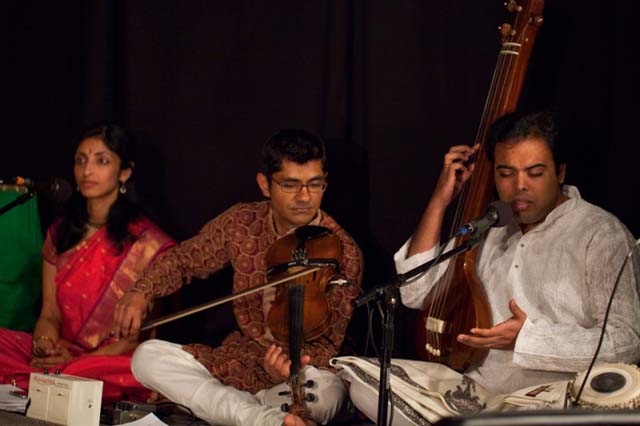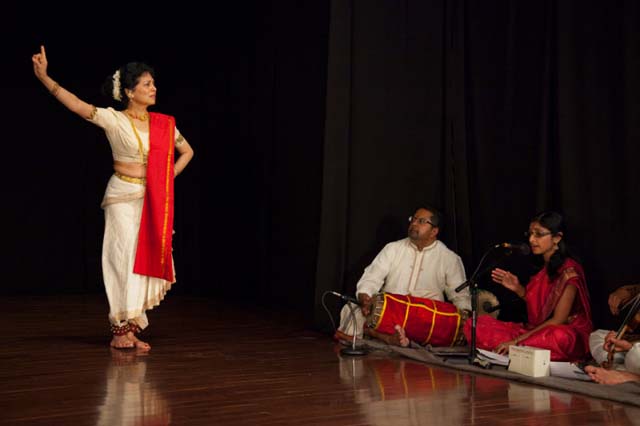The Vocalist – Shobana Ram

Carnatic and Hindustani Music – A collaboration
Things have a way of coming full circle: Shobana Ram, whose parents MK & Nirmala Ramasubramanian sang for Maya Kulkarni in the ’70s – gets to sing herself for this veteran dancer, forty years later. The event was “Bhinna Pravaaha: Memories of a Performing Artist” , a rare sighting of Maya Kulkarni, at the Anamika-Navatman Studios, which is an innovative new arts space in New York. This dance performance was the first in an ambitious program to introduce the work of noted artists of the past to a new audience.
Shobana Ram, who is also a dancer, choreographer and teacher besides being a singer, provided the powerful vocals for Maya Kukarni along with Samarth Nagarkar. With Kedar Havaldar on the tabla, Murali Balachandran on the mridangam and Vivek Rudrapatna on the violin, all performing just a few feet away from the audience, there was a palpable sense of depth and intimacy to the evening.
An accomplished Bharata Natyam dancer, Shobana has also received Carnatic training under the Bombay Sisters, Jayalakshmi Santhanam, and K. R. and Meera Kedaranathan (Semmangudi bani), and Marathi music with Bombay Jaishree. A memorable experience for her was actually getting to learn a piece from the legend M.S. Subbulakshmi. In New York, Shobana continues to make music with various choreographers including Parijat Desai, Malini Srinivasan and Satya Pradeep.
Q and A with Shobana Ram
1. What was the most challenging part of this performance with Maya?
For me, the most challenging part of this performance with Maya was taking a set of powerful lyrics from Bhavabhuti’s Uttara Ramacharitam and composing a piece that would do justice to the power and emotion of the theme. In the lyrics for “Vachastvaya”, Sita expresses her anguish and resolve when faced with the fact that Rama has abandoned her, believing that she is impure. Maya and I chose Raga Pantuvarali in Carnatic style, to bring out the pathos and raw emotion of the dance piece. But I’d never developed and sung a Carnatic piece just from lyrics, and that too, trying to follow the arc of the emotional journey in the way Maya wanted to portray it. It was definitely a challenge for me! But extremely satisfying to develop it so ‘organically’.
2. What kind of practice do such performances entail?
Working with an artist like Maya requires a very special kind of commitment. Maya wants to build a program together, rather than hand a CD of music to musicians, and have them learn it quickly in order to perform it. So, my practices with her were intense and deep, the kind where there is a true exchange of ideas, and a lovely opportunity to ‘experience’ the dance from a very core place. As a dancer myself, I loved it! I felt like I was able to, in a sense, dance with her, through the music. Maya has an extraordinary intelligence with regards to music, and though she may not always know how to describe what she wants exactly, her vision is very clear, and she gets it across beautifully.

3. The New York Times called your singing ‘a gentle unstoppable force of nature’ in one of your recent performances. How do you manage to sing, dance as well as teach?
I am a Teaching Artist in NYC and Long Island schools, so my schedule during the school year can be a bit erratic! Any given week can find me in as many as 3 different schools, either teaching an Indian dance residency, integrating performance and visual art with core academic subjects, or teaching Aesthetic Education.
It’s been a few years since I’ve taught dance privately in the community, but I’m hoping to revive that. Primarily, I perform dance whenever and wherever the opportunity presents itself – either with ensembles, classical and contemporary, or doing solo presentations. With two children, one has to find that elusive balance between mothering and running off to rehearsals and shows at odd hours of the day!
To be honest, singing had been on the back burner for a number of years, while I focused on dance. For me, singing has always been my first love, so it was always ‘with me’. I still take Carnatic lessons off and on with my aunt, Rajalakshmi Shankar. But I’d been missing it, and wanting to ‘get back to it. So, the opportunities to sing for dancer/ choreographers that I admire and respect, like Parijat Desai and Maya Kulkarni were just golden ones that I couldn’t pass up. In the end, I’m so glad I got over my initial trepidation and doubt, and just plunged into the process. Regardless of the result, the learning experience for me was priceless.
4. The number of Indian musicians – both Carnatic and Hindustani musicians – seem to be increasing in New York. Is there now a community here and how much fusion is there between the two forms?
Yes, New York is now bustling with excellent classical Indian musicians, from both Carnatic and Hindustani traditions, spanning different generations. I think there were always established musician-teachers living in the suburbs for many years (Queens, New Jersey), but it does seem like there is a growing concentration of younger musicians teaching and performing in the city now, many of whom are really trying to make a living of it, or at least an important side living.
Musicians like Arun Ramamurthy (violinist), Sameer Gupta (tabla), and Samarth Nagarkar (vocals) are all young musicians who are really setting a high standard for our music and are committed to ‘spreading the word’.
Re: ‘fusion’, careful, that’s a radioactive word! I think there are some lovely collaborations happening all over NY, and diasporic artists, both Carnatic and Hindustani, are just naturally sharing ideas and music with one another.
In the span of two weeks, I had the opportunity of performing with Carnatic and Hindustani musicians in two different shows, both of which had the goal of bringing the allied but different traditions together. As a dancer/singer who simply loves both North and South Indian classical dance and music traditions, and who’s grown up outside of India, collaboration is a no-brainer!
At the same time, I’d say, the more grounded you are in your particular tradition, be it Bharata Natyam dance in the Vazhuvoor style, or Hindustani music from the Gwalior gharana, the more you have to offer when the chance to integrate or collaborate presents itself – as long as you have an open mind and willingness to learn.
Next Page: The Space: Anamika Navatman Project

5 Comments
Pingback: Maya Kulkarni Chadda - The Woodstock Whisperer/Jim Shelley
Nice looking Indian classical dancer with actual talent. Beauty was in her feet with traditional foot bells, very beautiful feet…
Lovingly portrayed, Lavinia.You brought it all alive. New York is an amazing place for the unexpected surprises one encounters day after day. Kulkarni’s dual careers – fascinating.
I like Indian classical dancers’ beautiful feet with foot bells -ghungroos – it gives real excitement, pleasure and enjoyment.
Lavina
As usual, a beautiful story on Indian classical dance. We always encourage participation in classical and folk dances, and this will definitely encourage young people to learn more classical dance.